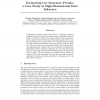Free Online Productivity Tools
i2Speak
i2Symbol
i2OCR
iTex2Img
iWeb2Print
iWeb2Shot
i2Type
iPdf2Split
iPdf2Merge
i2Bopomofo
i2Arabic
i2Style
i2Image
i2PDF
iLatex2Rtf
Sci2ools
107
Voted
NIPS
2001
2001
Estimating Car Insurance Premia: a Case Study in High-Dimensional Data Inference
Estimating insurance premia from data is a difficult regression problem for several reasons: the large number of variables, many of which are discrete, and the very peculiar shape of the noise distribution, asymmetric with fat tails, with a large majority zeros and a few unreliable and very large values. We compare several machine learning methods for estimating insurance premia, and test them on a large data base of car insurance policies. We find that function approximation methods that do not optimize a squared loss, like Support Vector Machines regression, do not work well in this context. Compared methods include decision trees and generalized linear models. The best results are obtained with a mixture of experts, which better identifies the least and most risky contracts, and allows to reduce the median premium by charging more to the most risky customers.
| Added | 31 Oct 2010 |
| Updated | 31 Oct 2010 |
| Type | Conference |
| Year | 2001 |
| Where | NIPS |
| Authors | Nicolas Chapados, Yoshua Bengio, Pascal Vincent, Joumana Ghosn, Charles Dugas, Ichiro Takeuchi, Linyan Meng |
Comments (0)

